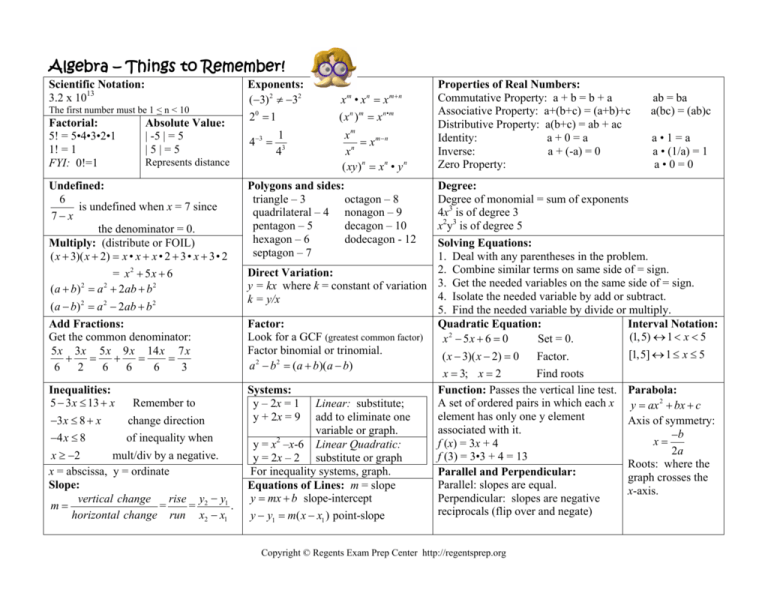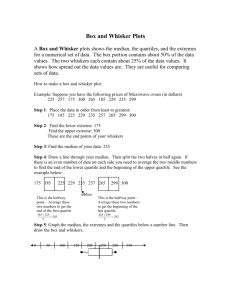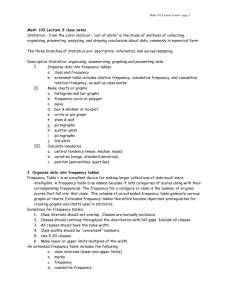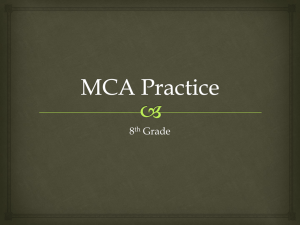Algebra – Things to Remember!
advertisement

Algebra – Things to Remember!
Scientific Notation:
3.2 x 1013
The first number must be 1 < n < 10
Factorial:
5! = 5•4•3•2•1
1! = 1
FYI: 0!=1
Absolute Value:
| -5 | = 5
|5|=5
4−3 =
Remember to
−3 x ≤ 8 + x
change direction
−4 x ≤ 8
of inequality when
x ≥ −2
mult/div by a negative.
x = abscissa, y = ordinate
Slope:
vertical change
rise y2 − y1
=
=
.
m=
horizontal change run x2 − x1
m+ n
x •x = x
( x n ) m = x n• m
m
n
xm
= x m−n
n
x
( xy ) n = x n • y n
1
43
Represents distance
Undefined:
6
is undefined when x = 7 since
7−x
the denominator = 0.
Multiply: (distribute or FOIL)
( x + 3)( x + 2) = x • x + x • 2 + 3• x + 3• 2
= x2 + 5x + 6
(a + b) 2 = a 2 + 2ab + b 2
(a − b) 2 = a 2 − 2ab + b 2
Add Fractions:
Get the common denominator:
5 x 3x 5 x 9 x 14 x 7 x
+
=
+
=
=
6
2
6
6
6
3
Inequalities:
5 − 3x ≤ 13 + x
Exponents:
(−3) 2 ≠ −32
20 = 1
Properties of Real Numbers:
Commutative Property: a + b = b + a
Associative Property: a+(b+c) = (a+b)+c
Distributive Property: a(b+c) = ab + ac
Identity:
a+0=a
Inverse:
a + (-a) = 0
Zero Property:
Polygons and sides:
triangle – 3
octagon – 8
quadrilateral – 4 nonagon – 9
pentagon – 5
decagon – 10
hexagon – 6
dodecagon - 12
septagon – 7
ab = ba
a(bc) = (ab)c
a•1=a
a • (1/a) = 1
a•0=0
Degree:
Degree of monomial = sum of exponents
4x3 is of degree 3
x2y3 is of degree 5
Solving Equations:
1. Deal with any parentheses in the problem.
2. Combine similar terms on same side of = sign.
Direct Variation:
y = kx where k = constant of variation 3. Get the needed variables on the same side of = sign.
4. Isolate the needed variable by add or subtract.
k = y/x
5. Find the needed variable by divide or multiply.
Quadratic Equation:
Interval Notation:
Factor:
2
(1,5) ↔ 1 < x < 5
Look for a GCF (greatest common factor)
x − 5x + 6 = 0
Set = 0.
Factor binomial or trinomial.
[1,5] ↔ 1 ≤ x ≤ 5
( x − 3)( x − 2) = 0
Factor.
a 2 − b 2 = (a + b)(a − b)
x = 3; x = 2
Find roots
Function: Passes the vertical line test. Parabola:
Systems:
A
set of ordered pairs in which each x y = ax 2 + bx + c
y – 2x = 1 Linear: substitute;
element has only one y element
y + 2x = 9 add to eliminate one
Axis of symmetry:
associated with it.
variable or graph.
−b
x=
f (x) = 3x + 4
y = x2 –x-6 Linear Quadratic:
2a
f (3) = 3•3 + 4 = 13
y = 2x – 2 substitute or graph
Roots: where the
For inequality systems, graph.
Parallel and Perpendicular:
graph crosses the
Parallel: slopes are equal.
Equations of Lines: m = slope
x-axis.
Perpendicular: slopes are negative
y = mx + b slope-intercept
reciprocals (flip over and negate)
y − y = m( x − x ) point-slope
1
1
Copyright © Regents Exam Prep Center http://regentsprep.org
Perimeter: add the distances around
the outside.
Trig: Right triangles only
Pythagorean Theorem:
2
2
2
o
a
o
Right Triangles only. c = a + b
sin A = ; cos A = ; tan A =
Triples: 3, 4, 5
h
h
a
Circumference: C = 2π r = π d
5, 12, 13
Angle of elevation: from horizontal line of sight up.
8, 15, 17
Angle of depression: from horizontal line of sight down.
7, 24, 25
Area:
Volume and Surface Area:
Data:
5 Statistical Summary: minimum, maximum, median, 1st quartile,
1
Vrectangular solid = l i wih
Atriangle = bh
3rd quartile
2
SArectangular solid = 2lh + 2hw + 2lw
Quartiles divide data into 4 equal parts.
s2 3
Vcylinder = π r 2 h
Percentiles divide data into 100 equal parts.
Aequilateral triangle =
4
2
number of scores below x
SAclosed cylinder = 2π rh + 2π r
Percentile rank of score x =
i100 , where n is
Arectangle = bh
n
Error in Measurement:
Asquare = bh = s 2
the number of scores.
Relative
error
=
|measure-actual|
Mean = average.
Aparallelogram = bh
actual
Mode = most often (may be more than one answer).
d1 id 2
%
of
Error
=
Relative
•
100%
Median = middle.
Arhombus = bh =
2
Outliers = values that are far away from the rest of the data.
Permutations:
1
Median best describes data if outliers exist.
Arrangement in specific order.
Atrapezoid = h(b1 + b2 )
Range = difference between the maximum and minimum values.
2
n!
2
n Pr =
Acircle = π r
(n − r )!
n
Probability: P(A’) = 1 – P(A) complement
Box and Whisker Plot: 1st and 3rd quartiles are at the
2
πr
Asector of circle =
ends of the box, median is a vertical line in the box, and
P(A and B) = P(A)•P(B) independent
360
the max/min are at the ends of the whiskers.
P(A and B) = P(A)•P(B/A) dependent
1
Asemicircle = π r 2
P(A
or
B)
=
P(A)
+
P(B)
mutually
exclusive
Helpful
in interpreting the distribution of data.
2
P(A or B) = P(A) + P(B) – P(A and B) not exclusive
1
P(B/A) = P(A and B)/P(A) conditional probability
Aquarter circle = π r 2
4
P(B/A) means probability of B given A has occurred.
Literal equations:
Sets:
Exponential Growth and Decay:
A ∪ B Union - all elements in both sets.
a = b + cd, solve for c.
Decay: y = ab x where a > 0 and 0 < b < 1
a – b = cd
A ∩ B Intersection - elements where sets overlap.
a–b=c
Growth: y = ab x where a > 0 and b > 1
d
Use same strategies A ' Complement - elements not in the set.
{ } or ∅ means null set.
as for solving equations.
Copyright © Regents Exam Prep Center http://regentsprep.org









